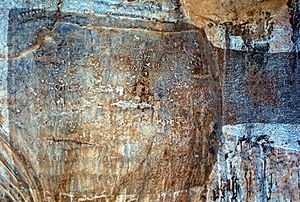الپارثية النقشية
| الپارثية النقشية Inscriptional Parthian | |
|---|---|
 النسخة الپارثية من نقش شاپور الأول في كعبة زرادشت | |
| النوع | |
| اللغات | اللغة الپارثية |
| الفترة الزمنية | 250 ق.م. |
النظم الوالدة | الأبجدية الآرامية
|
| الاتجاه | Right-to-left |
| ISO 15924 | Prti, 130 |
مرادف اليونيكود | Inscriptional Parthian |
| U+10B40–U+10B5F | |
الپارثية النقشية Inscriptional Parthian هي خط اِستُخدِم لكتابة اللغة الپارثية على عملات پارثيا منذ زمن Arsaces I of Parthia (250 BC). It was also used for inscriptions of Parthian (mostly on clay fragments) والفترات الساسانية اللاحقة (mostly on official inscriptions).
خط الپارثية النقشية كان يُكتب من اليمين إلى اليسار وحروفه غير متصلة.

الحروف
Inscriptional Parthian uses 22 letters:[1]
| Name[A] | Image | Text | IPA[2] |
|---|---|---|---|
| Aleph | 𐭀 | /a/, /aː/ | |
| Beth | 𐭁 | /b/, /v/ | |
| Gimel | 𐭂 | /g/, /j/ | |
| Daleth | 𐭃 | /d/, /j/ | |
| He | 𐭄 | /h/ | |
| Waw | 𐭅 | /v/, /r/ | |
| Zayin | 𐭆 | /z/ | |
| Heth | 𐭇 | /h/, /x/ | |
| Teth | 𐭈 | /t/ | |
| Yodh | 𐭉 | /j/, /ĕː/, /ĭː/ | |
| Kaph | 𐭊 | /k/ | |
| Lamedh | 𐭋 | /l/ | |
| Mem | 𐭌 | /m/ | |
| Nun | 𐭍 | /n/ | |
| Samekh | 𐭎 | /s/ | |
| Ayin | 𐭏 | /ʔ/ | |
| Pe | 𐭐 | /p/, /b/ | |
| Sadhe | 𐭑 | /s/ | |
| Qoph | 𐭒 | /q/ | |
| Resh | 𐭓 | /r/ | |
| Shin | 𐭔 | /ʃ/, /ʒ/ | |
| Taw | 𐭕 | /t/, /d/ |
الحروف المركبة
Inscriptional Parthian uses seven standard ligatures:[1]
| Ligature | Sequence | |
|---|---|---|
| Image | Text | |
| 𐭂𐭅 | 𐭂 (gimel) + 𐭅 (waw) | |
| 𐭇𐭅 | 𐭇 (heth) + 𐭅 (waw) | |
| 𐭉𐭅 | 𐭉 (yodh) + 𐭅 (waw) | |
| 𐭍𐭅 | 𐭍 (nun) + 𐭅 (waw) | |
| 𐭏𐭋 | 𐭏 (ayin) + 𐭋 (lamedh) | |
| 𐭓𐭅 | 𐭓 (resh) + 𐭅 (waw) | |
| 𐭕𐭅 | 𐭕 (taw) + 𐭅 (waw) | |
The letters sadhe (𐭑) and nun (𐭍) have swash tails which typically trail under the following letter.[1] For example:
| Ligature | Sequence | |
|---|---|---|
| Image | Text | |
| 𐭍𐭍 | 𐭍 (nun) + 𐭍 (nun) | |
| 𐭍𐭃 | 𐭍 (nun) + 𐭃 (daleth) | |
الأرقام
الپارثية النقشية كان لها أرقامها الخاصة بها:
| القيمة | 1 | 2 | 3 | 4 | 10 | 20 | 100 | 1000 | |
|---|---|---|---|---|---|---|---|---|---|
| العلامة | الصورة | ||||||||
| النص | 𐭘 | 𐭙 | 𐭚 | 𐭛 | 𐭜 | 𐭝 | 𐭞 | 𐭟 | |
Numbers are written right-to-left. Numbers without corresponding numerals are additive. For example, 158 is written as 𐭞𐭝𐭝𐭜𐭛𐭛 (100 + 20 + 20 + 10 + 4 + 4).[1]
يونيكود
Inscriptional Parthian script was added to the Unicode Standard in October, 2009 with the release of version 5.2.
The Unicode block for Inscriptional Parthian is U+10B40–U+10B5F:
| Inscriptional Parthian[1] Unicode.org chart (PDF) | ||||||||||||||||
| 0 | 1 | 2 | 3 | 4 | 5 | 6 | 7 | 8 | 9 | A | B | C | D | E | F | |
| U+10B4x | 𐭀 | 𐭁 | 𐭂 | 𐭃 | 𐭄 | 𐭅 | 𐭆 | 𐭇 | 𐭈 | 𐭉 | 𐭊 | 𐭋 | 𐭌 | 𐭍 | 𐭎 | 𐭏 |
| U+10B5x | 𐭐 | 𐭑 | 𐭒 | 𐭓 | 𐭔 | 𐭕 | 𐭘 | 𐭙 | 𐭚 | 𐭛 | 𐭜 | 𐭝 | 𐭞 | 𐭟 | ||
Notes
| ||||||||||||||||
المراجع
- ^ أ ب ت ث ج Everson, Michael; Pournader, Roozbeh (2007-08-24). "L2/07-207R: Proposal for encoding the Inscriptional Parthian, Inscriptional Pahlavi, and Psalter Pahlavi scripts in the SMP of the UCS" (PDF).
- ^ Daniels, Peter T.; Bright, William, eds. (1996). The World's Writing Systems. Oxford University Press, Inc. pp. 518. ISBN 978-0195079937.